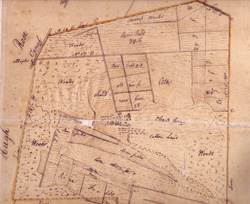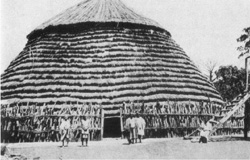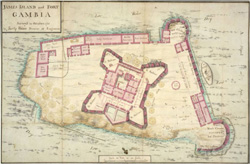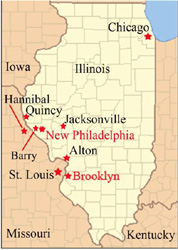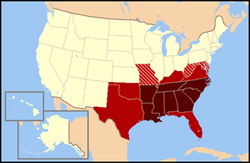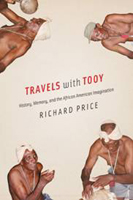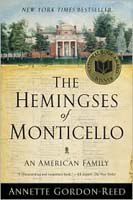  September 2009 NewsletterISSN: 1933-8651In this issue we present the following articles, news, announcements, and reviews:
Landscapes of Cultivation: Inland Rice Fields |
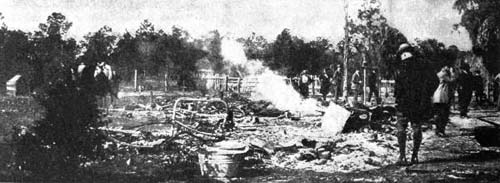 Photograph of the remains of Sarah Carrier's house in Rosewood, Florida, taken in the aftermath of the riot and massacre; published in Literary Digest magazine on January 20, 1923; courtesy Florida Memory Project, State Library and Archives of Florida. |
Now, the state of Florida has awarded Dunn's Miami-based community organization a grant to conduct an archaeological survey of the site. He believes he is the first black to buy land in Rosewood, 40 miles southwest of Gainesville, since it burned.
"It's such a powerful story, this black town and its success and its horrific end," says Dunn, a retired Florida International University professor. "The place and its history draw you in."
Dunn expects to find the bones of a rich 19th century culture -- artifacts, pottery and utensils, and traces of the Seaboard Air Line Railway and the depot that had served as a community center before becoming an escape route for some residents during the riots.
Whatever bits of Rosewood that researchers unearth will form the foundation of an exhibition to be based in South Florida. Dunn also hopes to reconstruct the depot.
What Used To Be"This is where they would go to sell turnips and tomatoes and eggs. This is where friends would hang until the train's arrival, which ended the night," said Dunn, who has produced a documentary, Remembering Rosewood. "This is where the town came together."
An empty, low-lying wooded patch of oaks, cedar and scrub, Dunn's property lies along a dirt road on the eastern end of Rosewood.
"The Rosewood story is an important part of our history," Dunn said. "I didn't want a house to be built on the land and we lose its historical significance."
First settled in 1845, Rosewood became home to about 100 blacks who had migrated from the Carolinas, lured by solid work at the lumber mills. For two decades, it prospered.
Residents had a school, three churches, turpentine and sugar-cane mills, a Masonic hall, the Rosewood Stars baseball team, and two general stores, one white-owned.
Families owned their land and livestock and made a decent living hunting, fishing and working at the mills.
On New Year's Day in 1923, a white woman accused an unnamed black man of assaulting her. In retaliation, white vigilantes attacked the residents of Rosewood. The town was looted and, ultimately, torched. Some residents fought back; some escaped on a train headed to Gainesville. Others fled into the woods.
Rosewood never really recovered. Over the years, a smattering of whites moved back into the area, but it never developed commercially.
For some two generations, one of the most extraordinary stories in Florida history remained cloaked in fear and silence until an investigative reporter named Gary Moore discovered the story in the early 1980s, launching Rosewood into the national spotlight.
Several years later, Dunn would begin traveling there as he researched Florida's history of racial violence. He has since been back dozens of times and has interviewed several of the survivors.
Preserving the PastIn 1994, the Florida Legislature passed a $2.1 million compensation bill, acknowledging neglect in protecting Rosewood's black residents during the massacre. Three years later, director John Singleton made a film about the tragedy.
In 2004, the state declared Rosewood a Florida Heritage Landmark, and a historical marker now stands on State Road 24 in front of the only house that survived the riots.
Levy County records show that Dunn and his friend James Cornett, who is the CEO of a music park in Live Oak and is the majority owner, paid $44,000 for the land they bought.
Then the Florida Division of Historical Resources awarded Dunn's Roots in the City organization a grant of almost $50,000 to do research and conduct the archaeological survey. Dunn is working with a team from the University of Florida's Department of Anthropology.
"We are trying to dig out the truth," Cornett says.
Already, a swath of scrub has been cleared, and the team has located the three-foot berm where the railroad tracks once lay.
"The depot tells the best part of the story," Dunn said. It sat right behind the house of a white family that, at great danger, hid black women and children from the rioters and helped them escape by train.
"This is one part of the story that has not been given fair shrift," Dunn said. "All of the whites in the area did not support what was going on."
James Davidson, the UF assistant professor of anthropology leading the survey, said the researchers will create a grid and conduct shovel tests. They expect to find objects just below the surface.
The year-long project would be Rosewood's first.
"From the time of the destruction to now, no one has gone in and scientifically examined the grounds," Davidson said. "If we find [the depot] and other objects, it will give us some sense of the flavor of the time. It will provide some context of life before Rosewood was ruined."
[Return to table of contents]Slave Route Museum Inaugurated in Matanzas, Cuba
Juventud Rebelde
June 17, 2009
Posted online June 17, 2009 by Juventud Rebelde News at
http://www.juventudrebelde.co.cu/cuba/2009-06-17/
slave-route-museum-inaugurated-in-matanzas-cuba/
Copyright 2009 Juventud Rebelde
Slave Route Museum Inaugurated in Matanzas, Cuba
UNESCO Executive Committee President Olabiyi Babalola Joseph spoke about how the Atlantic slave trade forms an essential part of the shared history of Africa, Europe, the Caribbean and Americas
Matanzas -- The wails induced by whips and chains is a part of history that still needs to be told. From the 16th to the 19th century, the exportation of slaves dominated relations between Europe and sub-Saharan Africa.
The slaves were not the only merchandise, but the most valuable. The slave trade was practiced by the Portuguese, Genovese, French, Dutch, Danes and English who brought no less than 20 million Africans to the Americas.
On Tuesday, the city of Matanzas inaugurated a national museum on the Slave Route in the San Severino castle.
 The museum has four exhibition spaces, including a command house, archaeological presentations on the legacies of slavery, and an exhibition on the orishas. Photograph by Juventud Rebelde News. |
Participants at the inauguration spoke about the indelible stamp left on the Cuban historic memory of those people who were violently uprooted from their lands and converted into slaves for cheap labor.
UNESCO Executive Committee President Olabiyi Babalola Joseph spoke about how the Atlantic slave trade forms an essential part of the shared history of Africa, Europe, the Caribbean and Americas.
Babalola said that the new museum represents a bridge among generations and is an interesting place to teach the African history and languages. He said the idea behind the Slave Route project is to break the silence on the immoral and ignoble practice of which Africa was a victim.
The Cuban museum hosts an important exhibition of pictures and texts. For instance, the visitor can learn about calimbo, a practice consisting of branding the Arican slave with a red-hot iron when they arrived as if they were animals, to identify them as a purchaser's property. They were branded on the stomach, arms or back and in the case of women on the chest or legs.
The castle that houses the museum laid its first stone on October 13, 1693 and was completed during the early 1700s.
UNEAC President Miguel Barnet spoke about the legacy of Fernando Ortiz, the islands first and foremost specialists on Afro-Cuba culture. He also spoke about the importance of being aware of what he called the sub-Saharan holocaust, "the worst ever known to humanity" and of the "stamp left by men and women who came to Cuba in thick chains, never to return to their lands, families and cultures."
Barnet also spoke about the importance of gaining a better understanding of Afro-Cuban religions, as one of the fundamental African legacies to Latin America and the Caribbean.
Also during the ceremony, Olabiyi Babalola Joseph Yai presented Cuban Minister of Culture Abel Prieto with the UNESCO Medal for the Cultural Diversity.
UNESCO Regional Office Director Van Hof said that the Slave Route project emerged in 1993 and in 2005 had three goals: to unveil the tragedy of slavery in different countries, to analyze the effects of slavery in contemporary societies and the changes and cultural heritage left by this tragedy, and to foster mutual understanding among peoples.
The Afro América exhibition was opened during the inauguration featuring 105 educational posters and 14 African sculptures donated by Cuban artist Lorenzo Padilla.
[Return to table of contents]Grants Assist Historically Black Colleges and Universities
to Repair Historic Buildings
Interior Recovery Funds Will Help Historically Black Colleges and Universities Repair Historic Buildings
Washington, D.C. -- Secretary of the Interior Ken Salazar announced today that 20 Historically Black Colleges and Universities (HBCUs) will be the beneficiaries of $14.25 million for historic preservation grants aimed at providing assistance in the repair of historic buildings on their campuses.
In a press conference at Howard University with university president Dr. Sidney A. Ribeau, Salazar noted that the Department made these funds available under the American Recovery and Reinvestment Act (ARRA) for projects that will repair and preserve campus buildings listed on the National Register of Historic Places.
“The recovery funds not only will restore historic buildings on these campuses but also will provide a boost to individuals and companies performing the repairs, college communities and related local economies,” Secretary of the Interior Ken Salazar said today.
The National Park Service invited all HBCUs to submit grant applications for grants to repair and preserve historic buildings on their campuses. The buildings selected for this apportionment of grant funds were assessed as being the most architecturally and historically significant buildings on these HBCU campuses, and as needing essential repairs to preserve them and make them useable.
These much needed repairs will address issues such as termite and wood rot damage, leaking roofs and water damage, asbestos and lead paint removal, masonry work, electrical rewiring, heating, air conditioning and ventilation systems and achieving accessibility for disabled persons.
IMLS 2009 Grants for African American History and Culture

Washington, DC. On July 21, 2009, the Institute of Museum and Library Services (IMLS) awarded $1.31 million to 11 organizations dedicated to preserving the history of African American life from the period of slavery to the present day as part of the Museum Grants for African American History and Culture (AAHC) program.
Since 2006, AAHC grants have helped African American museums and Historically Black Colleges and Universities (HBCUs) build capacity by supporting professional training, technical assistance, internships, and expert consultations. The grant program is authorized by the National Museum of African American History and Culture Act and developed in consultation with the Council and Director of the Smithsonian's National Museum of African American History and Culture (NMAHHC).
"African American history is American history, and the recipients of this year's African American History and Culture grants understand that they are cultivating the next generation of stewards of our collective American story," said Anne-Imelda Radice, Director of IMLS. "IMLS is proud to support their work."
The Institute of Museum and Library Services (IMLS) has announced that in July 2009 it awarded $1.31 million to 11 organizations "dedicated to preserving the history of African American life from the period of slavery to the present day." The Museum Grants for African American History and Culture program has been developed in consultation with the Smithsonian's National Museum of African American History and Culture. The 2009 grantees include: Black Archives History and Research Foundation (Miami, FL), Maryland African American Museum Corporation (Reginald F. Lewis Museum, Baltimore, MD), Living Classrooms Foundation (Baltimore, MD), BB King Museum and Delta Interpretive Center (Indianola, MS), American Jazz Museum (Kansas City, MO), Society for the Preservation of Weeksville and Bedford-Stuyvesant History (Brooklyn, NY), Afro-American Cultural Center (Charlotte, NC), Ohio Historical Society's National Afro-American Museum and Cultural Center (Wilberforce, OH), South Carolina State U's Stanback Museum (Orangeburg, SC), National Civil Rights Museum (Memphis, TN), and Northwest African American Museum (Seattle, WA).
In addition to grant making, IMLS works closely with the National Museum of African American History and Culture to convene an annual meeting for past grantees to share lessons learned and strengthen networks. On June 25-26, representatives of 16 current AAHC grantee institutions met in Washington to share the successes and challenges in implementing their IMLS-funded projects with their peers and IMLS staff. Kinshasha Holman Conwill, Deputy Director of the National Museum of African American History and Culture, Smithsonian Institution, and IMLS Director Radice both spoke to the group.
Projects highlighted at the meeting included a national profile of African American Museums; a project to build institutional capacity and sustainability of African American museums throughout Florida; and a series of workshops and a summer internship program designed to benefit African American museums in the Baltimore area. Project descriptions and additional information are available on the IMLS website, http://www.imls.gov/news/2009/072109_list.shtm.
[Return to table of contents]New Book
By Shihan de Silva Jayasuriya
Markus Wiener, Cloth, 360 pp.,
ISBN-13: 978-1-55876-471-2, Jan. 2009.
Description from the Publisher:
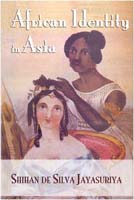 African movement to Asia, unlike the dispersion of slaves across the Atlantic, has not been recognized. Not being part of a significant economic network, forced migrations across the Red Sea and Indian Ocean, which have gone on for several centuries, have not received due attention. The commemorations, in 2007, of the bicentennial of Britain abolishing the trans-Atlantic slave trade has aroused some interest in other African migrations.
African movement to Asia, unlike the dispersion of slaves across the Atlantic, has not been recognized. Not being part of a significant economic network, forced migrations across the Red Sea and Indian Ocean, which have gone on for several centuries, have not received due attention. The commemorations, in 2007, of the bicentennial of Britain abolishing the trans-Atlantic slave trade has aroused some interest in other African migrations.While drawing attention to the strong military impact made by even first generation African migrants in Asia, and the descendants of the royal Africans who governed Sachin and Janjira (India), Shihan de Silva Jayasuriya demonstrates that African music and dance have, not only survived the brutalities of forced migration, but have also contributed to the local Middle Eastern and South Asian arts scene. While spirit possession ceremonies have been preserved as a form of cultural identity, new mixed forms of music which evolved in Asia have now become indigenized in the host countries. Unconsciously, forced African migrants have become cultural brokers between two Continents.
Combining historical accounts, both documented and oral, the silent history and conflicting identity of Asia’s Africans is explored through case studies, and processes of assimilation, social mobility and marginalization.
[Return to table of contents]
New Book
By Leslie A. Schwalm
University of North Carolina Press, Cloth, 400 pp.,
ISBN-10: 0807859508, ISBN-13: 978-0807859506, June 2009.
Description from the Publisher:
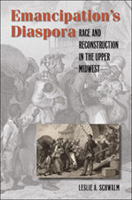 Most studies of emancipation's consequences have focused on the South. Moving the discussion to the North, Leslie Schwalm enriches our understanding of the national impact of the transition from slavery to freedom. Emancipation's Diaspora follows the lives and experiences of thousands of men and women who liberated themselves from slavery, made their way to overwhelmingly white communities in Iowa, Minnesota, and Wisconsin, and worked to live in dignity as free women and men and as citizens.
Most studies of emancipation's consequences have focused on the South. Moving the discussion to the North, Leslie Schwalm enriches our understanding of the national impact of the transition from slavery to freedom. Emancipation's Diaspora follows the lives and experiences of thousands of men and women who liberated themselves from slavery, made their way to overwhelmingly white communities in Iowa, Minnesota, and Wisconsin, and worked to live in dignity as free women and men and as citizens.Schwalm explores the hotly contested politics of black enfranchisement as well as collisions over segregation, civil rights, and the more informal politics of race -- including how slavery and emancipation would be remembered and commemorated. She examines how gender shaped the politics of race, and how gender relations were contested and negotiated within the black community. Based on extensive archival research, Emancipation's Diaspora shows how in churches and schools, in voting booths and Masonic temples, in bustling cities and rural crossroads, black and white Midwesterners -- women and men -- shaped the local and national consequences of emancipation. Leslie Schwalm is associate professor of history, women's studies, and African American studies at the University of Iowa, and author of A Hard Fight for We: Women's Transition from Slavery to Freedom in South Carolina.
[Return to table of contents]
New Book
Edited by Rosemary Brana-Shute and Randy J. Sparks
University of South Carolina Press, Cloth, 432 pp.,
ISBN-13: 978-1-57003-774-0, June 2009.
Description from the Publisher:
An international comparative study of a mode of emancipation that worked to reinforce the institution of slavery: Manumission -- the act of freeing a slave while the institution of slavery continues -- has received relatively little scholarly attention as compared to other aspects of slavery and emancipation. To address this gap, editors Rosemary Brana-Shute and Randy J. Sparks present a volume of essays that comprise the first-ever comparative study of manumission as it affected slave systems on both sides of the Atlantic.
In this landmark volume, an international group of scholars consider the history and implications of manumission from the medieval period to the late nineteenth century as the phenomenon manifested itself in the Old World and the New. The contributors demonstrate that although the means of manumission varied greatly across the Atlantic world, in every instance the act served to reinforce the sovereign power structures inherent in the institution of slavery. In some societies only a master had the authority to manumit slaves, while in others the state might grant freedom or it might be purchased. Regardless of the source of manumission, the result was viewed by its society as a benevolent act intended to bind the freed slave to his or her former master through gratitude if no longer through direct ownership. The possibility of manumission worked to inspire faithful servitude among slaves while simultaneously solidifying the legitimacy of their ownership.
The essayists compare the legacy of manumission in medieval Europe; the Jewish communities of Levant, Europe, and the New World; the Dutch, French, and British colonies; and the antebellum United States, while exploring wider patterns that extended beyond a single location or era. They also document the fates of manumitted slaves, some of whom were accepted into freed segments of their societies; while others were expected to vacate their former communities entirely. The contributors investigate the cultural consequences of manumission as well as the changing economic conditions that limited the practice by the eighteenth century to understand better the social implications of this multifaceted aspect of the system of slavery. Contributors include: Robin Blackburn, Debra G. Blumenthal, Rosemary Brana-Shute, Eric Burin, John F. Campbell, Sean Condon, Mary Caroline Cravens, Mariana L. R. Dantas, Ellen Eslinger, Keila Grinberg, Scott Hancock, Evelyn P. Jennings, Wim Klooster, Beatriz Galloti Mamigonian, Orlando Patterson, William D. Phillips, Jonathan Schorsch, Randy J. Sparks, and Eva Sheppard Wolf.
[Return to table of contents]
New Book
Edited by Ana Lucia Araujo
Cambridge Scholars Publishing, Cloth, 290 pp.,
ISBN-10: 1443809985, ISBN-13: 978-1443809986, July 2009.
Description from the Publisher:
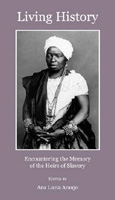 This book focuses on the several forms of reconstructing the slave past in the present. The recent emergence of the memory of slavery allows those who are or who claim to be descendents of slaves to legitimize their demand for recognition and for reparations for past wrongs. Some reparation claims encompass financial compensation, but very often they express the need for memorialization through public commemoration, museums, and monuments. In some contexts, presentification of the slave past has helped governments and the descendants of former masters and slave merchants to formulate public apologies. For some, expressing repentance is not only a means to erase guilt but also a way to gain political prestige. The authors analyse different aspects of the recent phenomenon of memorializing slavery, especially the practices employed to stage the slave past in both public and private spaces. The essays present memory and oblivion as part of the same process; they discuss reconstructions of the past in the present at different public and private levels through historiography, photography, exhibitions, monuments, memorials, collective and individual discourses, cyberspace, religion and performance. By offering a comparative perspective on the United States and West Africa, as well as on Western Europe, South America, and the Caribbean, the chapters offer new possibilities to explore the resurgence of the memory of slavery as a transnational movement in our contemporary world.
This book focuses on the several forms of reconstructing the slave past in the present. The recent emergence of the memory of slavery allows those who are or who claim to be descendents of slaves to legitimize their demand for recognition and for reparations for past wrongs. Some reparation claims encompass financial compensation, but very often they express the need for memorialization through public commemoration, museums, and monuments. In some contexts, presentification of the slave past has helped governments and the descendants of former masters and slave merchants to formulate public apologies. For some, expressing repentance is not only a means to erase guilt but also a way to gain political prestige. The authors analyse different aspects of the recent phenomenon of memorializing slavery, especially the practices employed to stage the slave past in both public and private spaces. The essays present memory and oblivion as part of the same process; they discuss reconstructions of the past in the present at different public and private levels through historiography, photography, exhibitions, monuments, memorials, collective and individual discourses, cyberspace, religion and performance. By offering a comparative perspective on the United States and West Africa, as well as on Western Europe, South America, and the Caribbean, the chapters offer new possibilities to explore the resurgence of the memory of slavery as a transnational movement in our contemporary world.Ana Lucia Araujo is an Assistant Professor in the Department of History at Howard University. Her research deals with the history and the memory of slavery in Brazil and the Bight of Benin. Contributors to this edited volume include: Leslie A. Schwalm, Charmaine Nelson, Carisa Worden, Christine Chivallon, Valika Smeulders, María Margarita Flores-Collazo, Humberto Garcia Muniz, Joshua M. Rosenthal, Margrit Prussat, Eduardo Franca Paiva, and Alessandra Brivio.
[Return to table of contents]
New Book
By Verene Shepherd
Ian Randle Publishers, Paperback, 325 pp.,
ISBN-10: 976637256X, ISBN-13: 978-9766372569, August 2009.
Description from the Publisher:
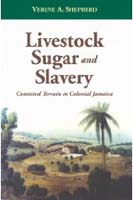 Livestock, Sugar and Slavery examines the evolution and expansion of the pen-keeping industry, the role and status of the pen-keepers and the experiences of the enslaved labourers on pens, a virtually unexplored area of Caribbean history. It argues that the relationship between those who raised livestock and those who grew sugar cane, while symbiotic in one sense, was also conflict-ridden in another. There were contests between sugar proprietors and pen-keepers over land, boundaries, enslaved labourers, and social and political status, demonstrating that the ranking game was intensely practised in the age of modernity. Complete with copious notes and an extensive bibliography, Livestock, Sugar and Slavery provides a comprehensive source material for students and academics interested in colonial Jamaica. Verene Shepherd is Professor of Social History at the University of the West Indies, Mona, and author of several books on Caribbean history.
Livestock, Sugar and Slavery examines the evolution and expansion of the pen-keeping industry, the role and status of the pen-keepers and the experiences of the enslaved labourers on pens, a virtually unexplored area of Caribbean history. It argues that the relationship between those who raised livestock and those who grew sugar cane, while symbiotic in one sense, was also conflict-ridden in another. There were contests between sugar proprietors and pen-keepers over land, boundaries, enslaved labourers, and social and political status, demonstrating that the ranking game was intensely practised in the age of modernity. Complete with copious notes and an extensive bibliography, Livestock, Sugar and Slavery provides a comprehensive source material for students and academics interested in colonial Jamaica. Verene Shepherd is Professor of Social History at the University of the West Indies, Mona, and author of several books on Caribbean history.[Return to table of contents]
New Book
Candomble and the Creation of Afro-Brazilian Identity
By Beatriz Gois Dantas
University of North Carolina Press, Cloth, 208 pp.,
ISBN-10: 0807859753, ISBN-13: 978-0807859759 , September 2009.
Description from the Publisher:
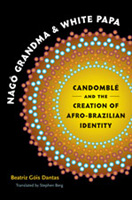 Nago Grandma and White Papa is a signal work in Brazilian anthropology and African diaspora studies originally published in Brazil in 1988. This edition makes Beatriz Gois Dantas's historioethnographic study available to an English-speaking audience for the first time.
Nago Grandma and White Papa is a signal work in Brazilian anthropology and African diaspora studies originally published in Brazil in 1988. This edition makes Beatriz Gois Dantas's historioethnographic study available to an English-speaking audience for the first time.Dantas compares the formation of Yoruba (Nago) religious traditions and ethnic identities in the Brazilian states of Sergipe and Bahia, revealing how they diverged from each other due to their different social and political contexts and needs. By tracking how markers of supposedly "pure" ethnic identity and religious practice differed radically from one place to another, Dantas shows the social construction of identity within a network of class-related demands and alliances. She demonstrates how the shape and meaning of "purity" have been affected by prolonged and complex social and cultural mixing, compromise, and struggle over time. Ethnic identity, as well as social identity in general, is formed in the crucible of political relations between social groups that purposefully mobilize and manipulate cultural markers to define their respective boundaries -- a process, Dantas argues, that must be applied to understanding the experience of African-descended people in Brazil.
In this signal work in Brazilian anthropology and African diaspora studies, Dantas compares the formation of religious traditions and ethnic identities in the Brazilian states of Sergipe and Bahia, revealing how they diverged from each other due to their different social and political contexts and needs. This volume makes the book, originally published in Brazil, available in English for the first time.
[Return to table of contents]
New Film
By Omohundro Institute of Early American History and Culture
University of North Carolina Press, 2 DVDs (40 min. and 50 min.), film text, teacher's guide, published for the Omohundro Institute of Early American History and Culture, Williamsburg, Virginia, Paperback ISBN 978-0-8078-6756-3, April 2009.
Description from the Publisher:
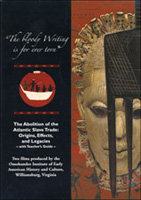 In August 2007, the Omohundro Institute of Early American History and Culture convened an international conference in the Republic of Ghana to consider the consequences of decisions made and implemented by the governments of Denmark, Great Britain, and the United States between 1792 and 1808 to end their participation in the Atlantic slave trade. The first pan-African congress of historians held on that continent since 1961, the four-day conference included 300 scholars, students, and other participants from twenty-three different countries, more than half in sub-Saharan Africa. This two-disc DVD set is drawn from that meeting, which began as an idea for an academic conference and became a transformative experience.
In August 2007, the Omohundro Institute of Early American History and Culture convened an international conference in the Republic of Ghana to consider the consequences of decisions made and implemented by the governments of Denmark, Great Britain, and the United States between 1792 and 1808 to end their participation in the Atlantic slave trade. The first pan-African congress of historians held on that continent since 1961, the four-day conference included 300 scholars, students, and other participants from twenty-three different countries, more than half in sub-Saharan Africa. This two-disc DVD set is drawn from that meeting, which began as an idea for an academic conference and became a transformative experience.The Bloody Writing is for Ever Torn is set in Elmina and Cape Coast castles, two restored sixteenth-century slave trading forts from which 1.8 million enslaved people were transported to the Americas and the Caribbean between 1500 and 1867. In words and through cultural performances, this film captures multiple understandings of a painful, fiercely contested past and the sharing of historical knowledge and lived experience that characterized the conference.
The Abolition of the Atlantic Slave Trade: Origins, Effects, and Legacies combines a distillation of some of the meetings sharply different scholarly perspectives and interpretations with compelling images and graphics in a format specifically designed for classroom use. The DVD is accompanied by a film text and a teacher's guide.
[Return to table of contents]
John Brown, Slavery, and the Legacies of
Revolutionary Violence in Our Own Time
Gilder Lehrman Center 11th Annual International Conference
Oct 29-31, 2009, Yale University, New Haven, CT.
Discussions of the place of violence -- its forms, its causes, its justice or injustice -- in American history often begin with John Brown and his exploits in Kansas and at Harpers Ferry, Virginia, in the 1850s. Brown's image has been appropriated by groups from the left and the right. He is a historical as well as a legendary figure, and often the myth overshadows the reality. This conference will explore the meaning and memory of John Brown as well as the problem of violence in American culture, past and present. For information on the conference visit: http://www.yale.edu/glc/john-brown/index.htm.
[Return to table of contents]Scraping By: Wage Labor, Slavery,
and Survival in Early Baltimore
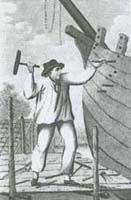
The Program in Early American Economy and Society of the Library Company of Philadelphia will hold its Eighth Annual Conference on Friday, October 30, 2009, 2-7 pm., at 1314 Locust Street, Philadelphia, Pennsylvania.
Seth Rockman's recently published study, Scraping By, brings to life the enslaved mariners, white seamstresses, Irish dockhands, free black domestic servants, and native-born street sweepers who navigated the low-end labor market in booming post-Revolutionary Baltimore. In the city's variegated workforce, race, age, family structure, and gender were crucial markers of economic opportunity and vulnerability. Baltimore's emergent capitalism also featured many slaves earning wages and white workers performing arduous labor for inadequate pay. Rockman analyzes the material experiences of these workers, how they found work, translated labor into food, fuel, and rent, and navigated underground economies and social welfare systems. He also explores what happened when they failed to find work or lost their jobs. His rich accounts of day laborers and domestic servants illuminate the history of early republic capitalism and its consequences for working families. Rockman's study is a powerful addition to scholarship about the hidden labor of capitalist economies where the unpaid and mundane, but vital, tasks of sewing, washing, feeding, provisioning, and boarding were an important complement to the backbreaking work of making Baltimore.
This conference will feature a discussion of Rockman's important new book, organizes around three thirty-minute presentations by Mary Ryan, Michael Zuckerman, and David Roediger, plus a response by Seth Rockman, followed by what promises to be a lively audience discussion. Copies of presentations will be posted by October 10, 2009 on the PEAES website, where you can also register in advance for the conference: www.librarycompany.org/Economics. For more information contact Cathy Matson, PEAES Director, at cmatson@udel.edu.
[Return to table of contents]Society for Historical Archaeology
43rd Annual Conference

The 43rd Annual Conference on Historical and Underwater Archaeology will be held at Amelia Island Plantation, located just north of Jacksonville, Florida. Amelia Island is situated between the Atlantic Ocean and the Intracoastal Waterway, providing the perfect setting for this year’s conference theme, Coastal Connections: Integrating Terrestrial and Underwater Archaeology. Coastal communities of all sizes provide many opportunities for archaeological discussion on current research and theoretical approaches to the coast, but also provide an opportunity to discuss archaeological responsibilities within the profession, and with the public.
Events related to African diaspora archaeology include the following panels and symposia (among others): available tours of Fort Mose State Park, the site of one of America's first free black settlements, and Kingsley plantation; Behind the Scenes of Time Team America at New Philadelphia, Illinois; What's New in Plantation Archaeology; the Archaeology of Freedom; African Diasporas in the South, a Conversation with John Michael Vlach (the ADAN annual forum); Multiplicity, Remembering, and Forgetting the Recent African American Past; "Standing the Heat," the Material Culture of Kitchens; Cosmopolitanism and Ethnogenesis, Colonialism and Resistance, Florida in Global Perspective; Re-assessing the Archaeology of Fort George Island, Florida, 1587-2009; Mortuary and Cemetery Studies; the Life and Times of Leland Ferguson: From Mississippian to Moravia; Archaeology at a Presidential Plantation, James Madison's Montpelier; Contributions to New World African Diaspora Archaeology; Current Research into Historical Landscapes; and African Historical Archaeology, Diasporic Conversations.
[Return to table of contents]Race, Labor and Citizenship
in the Post-Emancipation South
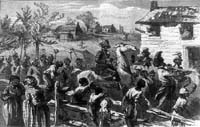
Call for Papers. The Race, Labor and Citizenship in the Post-Emancipation South conference will be held March 11-13, 2010, at the College of Charleston, South Carolina. The keynote address will be delivered by Steven Hahn, author of the prize-winning A Nation Under Our Feet: Black Political Struggles in the Rural South from Slavery to the Great Migration.
One hundred years ago the outstanding African American scholar-activist, W. E. B. Du Bois, presented to the American Historical Association a paper entitled 'Reconstruction and Its Benefits.' In the paper and in his seminal Black Reconstruction, published a quarter century later, Du Bois not only exposed the racial assumptions underpinning the then dominant view of the period following slave emancipation: he insisted that the struggles over slavery and the shape of the freedom that followed were central to the history of America's working people, calling it 'the kernel and meaning of the labor movement in the United States.' Over the past generation, historians have built upon Du Bois9s powerful insight about the connections between race, labor and citizenship in the post-emancipation South, producing some of the most compelling scholarship in the field of U.S. history.
The After Slavery Project, a transatlantic research collaboration based at Queen's University Belfast, welcomes proposals from scholars at all levels for individual papers and panels that showcase new and developing research on these and related themes across the former slave South, between the end of the Civil War and the early years of the twentieth century. As part of our commitment to making this scholarship widely available to teachers and students outside of higher education, labor and community activists, and interested citizens, we invite proposals for teachers' workshops and panels that attempt to link new scholarship and public/popular history and/or online learning.
Suggested topics include: Labor and the Politics of Reconstruction Freedwomen, Citizenship and the Public Sphere; Freedom, Property Rights and the Land Question in the Postwar South; Black Workers, the Union Leagues and the Republican Party; White Supremacy and the Prospects for Interracialism; The Franchise and Grassroots Political Activism; Coercion, Paramilitary Violence and Resistance; Emigration Movements and Black Mobility; Gender and the Free Labor Vision; Religion and Southern Laborers; Dockworkers, Port Cities and Black Mobilization; Race Leadership after 'Redemption'; Populism and the Color Line; Agricultural and Urban Labor; Race, Labor and New South Industrialization; and Independent Politics after 1880.
Proposals (limit 200 words/paper) should be submitted by November 20, 2009 either electronically to charlestonconference@afterslavery.com or by completing the online form at the After Slavery website, http://www.afterslavery.com.
[Return to table of contents]Impact of the Atlantic World on
the "Old Worlds" in Europe and Africa
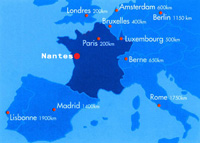
An International Conference on the Impact of the Atlantic World on the "Old Worlds" in Europe and Africa from the Fifteenth to the Nineteenth Centuries, will be held at the Université de Nantes, France, June 7-9, 2010.
The Atlantic world, formed between the fifteenth and the nineteenth centuries, maintained tight relations with the Mediterranean, the Indian Ocean, and the Pacific. Its specificity, however, lay in the conjunction of three interrelated phenomena whose entangled effects were not found elsewhere: European colonization, the slave trade, and racialized slavery. This symbiosis led to the formation of original new societies in the Americas, which differed from the European, African, and Native societies from which they were born. Moreover, the societies of origin in the "Old Worlds," from which large numbers of people left for the Americas, were also forever changed in return.
If the new Atlantic history has benefited from an enthusiastic reception, it has also given rise to intense debate. One of the numerous criticisms, as voiced by Alison Games, is that the new historiographical current risks offering only "an expanded history of the colonial Americas." In order to verify the relevance of the Atlantic paradigm, this conference seeks to reverse viewpoints by focusing on the transformations in Europe and Africa that resulted from their integration in trans-Atlantic dynamics. While the new Atlantic history has mostly been investigated by historians of the "New World," and while specialists of North America clearly dominate the field, this conference seeks to reach out to historians of Africa and Europe in order to enlarge and enrich a still unexplored question. The goal is thus to gather together the whole community of historians potentially concerned with Atlantic history.
Since the Atlantic world was born of both European and African migrations, the conference will consider both continents together. Atlantic history begins with the Portuguese explorations along the coasts of West Africa from the outset of the fifteenth century. These travels led to the development of long-lasting phenomena: the beginning of the Atlantic African slave trade first to Europe then to the Americas, the creation of the big slave plantation model in the African islands like São Tomé before its transfer to the "New World," and the formation of the first Creole societies in the Euro-African Atlantic world. However, Europe and Africa were not linked by the same imperial relations that united Europe and the Americas. The Atlantic slave trade developed precisely because the African kingdoms maintained their sovereignty. It is only from the middle of the nineteenth century that Europeans really began to colonize the interior of Africa, while the Atlantic slave trade was abolished everywhere. The comparison of the impact of the Atlantic world on Europe and on Africa will be one of the main questions of this conference.
Which Europe and Africa were affected by these transformations? No frontiers have been set a priori: the relative importance of the Atlantic world in geographical and social space with variable dimensions is another question that will to be explored during the conference. In addition, the inclusion of all social actors means that we will take into account individuals and groups from all social and ethnic backgrounds. One first series of interrogations will deal with the degree to which various Africans and Europeans' lives were affected by the formation of an Atlantic world. Who was concerned by and who cared about the Atlantic world? Was the Atlantic world part of the social imagination of European and African populations and societies? Who had knowledge of it; what was the quality of that information; how did they acquire it? Who were the individuals and groups that had imperial and Atlantic interests?
In order to analyse all the possible transformations of Africa and Europe that resulted from interconnections developed in the Atlantic world, the conference intends to exclude no historical field from the collective reflection, including political, military, economic, social, religious, and cultural arenas. Of course, it will be impossible to exhaust all of these research inquiries: the conference only aims to raise new questions as to how an Atlanticist perspective reveals new perspectives on European and African history.
The conference also does not wish a priori to put aside old debates, such as the demographic impact of European and African migrations on areas of departure, the role of the slave trade and colonial trade in the launching of the industrial revolution, the effects of the slave trade on African economies, or the transformations of consumption in Europe and Africa, if they are renewed with original perspectives, through, for example, the comparison between Europe and Africa. In regard to the impact of trans-Atlantic exchanges on European and African economies, several gateways are conceivable, such as the conditions and effects of the marketing of one product (European or American in Africa / American or African in Europe), the complexity of trade circulations and networks through various scales of analysis, the interlope on European coasts, the rivalries between African states and European powers on African coasts, war not as a recurrent accident that disrupted Atlantic exchanges but as a means to restore trade balances and payments of the various colonial powers, etc.
As for the socio-cultural effects, papers might consider migrations of "Americans" from all backgrounds (the return of European migrants and the arrival of Natives, African slaves, and free people of color in Europe, as well as projects of colonization by former slaves and descendants of slaves in Africa), the slave trade to Europe, the settling of Europeans and the formation of Euro-African societies in Africa. It would also be very fruitful to consider the "New World" as a space of social experimentation for re-considering work, gender, and race on the other side of the Atlantic. Through a complex system of circulations back and forth, European and African societies were transformed by the development of racial ideologies and the racialization of political and social orders that went with the formation of an Atlantic world.
Finally, the conference will explore the nature of political relations linking Europe and Africa to the rest of the Atlantic world. Papers could re-consider, concepts of domination, empire, and the "colonial situation," or trace the evolution over time of these political forms and systems, before, during, and after the era of revolutions. Since the emphasis is on the "Old Worlds," particular attention should be paid to imperial institutions, colonial lobbies, debates related to the colonies, slave trade, and slavery, and to the abolitionist movements in metropoles. The role of imperialism in the development of modern states in Europe and the transformations of African kingdoms with their integration in trans-Atlantic dynamics will also be of interest.
If you would like to present a paper at the conference, please send a short CV and a summary of your paper (no more than 2,000 characters) in French, English or Spanish before October 31st, 2009. Papers will be selected before November 30, 2009. The papers may not exceed 60,000 characters or 10,000 words (including spaces, footnotes, and bibliography). They will be pre-circulated and thus must be sent to the organizers before April 30, 2010. During the conference, papers will be quickly summarized in order to give more time to the discussion, which will be initiated by a commentator. French, English, and Spanish will be the languages of the conference. Summaries, CV, and papers should be sent to the organizers by e-mail: Guy Saupin, CRHIA-Université de Nantes: guy.saupin@univ-nantes.fr Cécile Vidal, CENA-EHESS, Paris: cecile.vidal@ehess.fr.
[Return to table of contents]Portugal and Africa: Accounts, Connections, Identities
Call for Papers. A conference entitled Portugal and Africa: Accounts, Connections, Identities (Fifteenth through Eighteenth Centuries) will be held October 21-22, 2010, hosted by the Centre d'Études des Mondes Africains at CEMAf-Paris, Université Paris 1 Panthéon-Sorbonne, 9 rue Malher, 75004 Paris, France.
The aim of the conference is to revisit the "Portuguese" presence in Africa between the fifteenth and the eighteenth centuries -- an often neglected era in contemporary research.
For a long time historians have dealt mostly with the so-called Discoveries (from the end of the fifteenth century to the early sixteenth century), seen then as a glorious moment in Iberian expansion. Scholars tended to pay much less attention to the longue durée and consequently fostered the idea of a rapid decline of the Portuguese empire. First, it appears necessary to question the interactions between the "Portuguese" and Africa over the longue durée and to avoid periodizations that rely solely on the logic of the Portuguese Empire. Second, it seems essential to do away with two major tendencies: on the one hand, a lusocentric approach which often leads to the writing a "history of the Portuguese in Africa"; on the other hand, an Africa-centred orientation which frequently uses Portuguese evidences less than critically and tends to overestimate or, conversely, underestimate the Portuguese "factor".
To avoid binary interpretations and compartmentalisations, one needs to question and to integrate these different historiographies. It is also necessary to go beyond an essentialist approach to Portuguese, African, or even Luso-African and Afro-Portuguese, societies, as well as to the Portuguese empire. It is fundamental to take into account their heterogeneity and their internal divisions and to re-insert the historical actors in both space and time. Such a position further invites in depth examination of categories and concepts usually employed, such as "Portuguese," "Luso-Africans," "métissage," "connections," "empire," "colony" and so on. Finally, this re-thinking requires historians to go back to the circumstances in which both European and African accounts of this period were produced, so as to consider these accounts as social products: chronicles, missionary works, travel accounts, administrative documentation and local traditions.
To cope with these issues the analysis of connections and transfers, at local, regional and global levels is obviously needed. Past research on the cultural interactions in the early modern era, for instance on the Luso-Africans or Afro-Portuguese of Western Africa, has demonstrated the flexible and multiple nature of identities. Yet such cultural exchanges and transformations all had their limitations and were faced with power struggles and processes of domination, all of which merit renewed examination.
In this manner, through the study of the "modes of interactions" between the "Portuguese" and the "Africans," we seek to shed more precise light on Portuguese societies overseas, as well as those African societies which they encountered.
Interested scholars are encouraged to propose case studies and place Africa within interactions on a global scale (Europe, Asia and America). We invite papers submitted on the following themes, but other related topics are also welcome: Individual itineraries, empire's margins and interstitial positions, urban mixing and hinterland's fiefdoms; Circulation of men and women, items and ideas; Acculturations, solidarities and hierarchies; Depiction of Portuguese, Africans, Luso-Africans and Afro-Portuguese in European and African accounts. In addition, the conference is open to papers that consider Luso-African experiences (Asia, America) in a comparative perspective.
Titles and abstracts are due by November 15th 2009. To apply, please send the following information to both coordinators: Title, Abstract (approximately 300 words in length), Short CV. Conference languages are French and English. According to contributors' specific situations, travel expenses may partly be funded. Coordinators: Hervé PENNEC (CNRS - CEMAf-Aix-en-Provence): pennec@mmsh.univ-aix.fr; Thomas VERNET (Université Paris 1 - CEMAf-Paris): thomas.vernet@univ-paris1.fr
[Return to table of contents]Preserving African Cultural Heritage

The University Cheikh Anta Diop (UCAD) of Dakar, and Institut Fondamental d'Afrique Noire Cheikh Anta Diop (IFAN-CAD), are pleased to announce the joint organization of the 13th PAA Congress (Panafrican Association of Prehistory and Assimilated Disciplines), and the 20th conference of the SAFA (Society of Africanist Archaeologists). This unprecedented opportunity to bring together members of these two associations dedicated to African Prehistory, in African soil, will certainly represent a turning point in the history of African Archaeology. This meeting will be held November 1-7, 2010 at the University Cheikh Anta Diop in Dakar, Senegal.
Themes. The local organizing committee proposes the following list of topics: 1. Geology of the Quaternary; 2. Hominids Evolution; 3. Paleo-Environments and the peopling of Africa; 4. Prehistoric Art in Africa; 5. Transition from Stone to Metal; 6. Food Production; 7. Pastoralism; 8. Megalithism in Africa; 9. The African Iron Age; 10. Complex Societies; 11. Power, Society and State Formation; 12. New Research on Urbanization and Cities in Africa; 13. Historical Archaeology in Africa; 14. Recomposed Past: The Archaeology of Identity in Africa; 15. The Archaeology of Inequality: Gender, Class and Material Culture in Africa; 16. Population Movements in African Past: Rethinking Migration; 17. The Archaeology of African Diasporas; 18. Heritage Management in Africa; 19. Ethnoarchaeology in Africa : Beyond Analogy? 20. Matter and Techniques; 21. Experimental Archaeology; 22. African Languages; 23. Bioarchaeology; 24. Archaeology and NTICs in Africa.
Participants are encouraged to propose additional topics and initiate thematic panels. It is desirable that teams working on specific or related issues lead sessions. Abstracts must be submitted either in French or English, and no later than April 30th, 2010, at the following address: Panaf/Safa2010, Laboratoire d'Archéologie, IFAN Cheikh Anta Diop, BP : 206 DAKAR – Senegal. Tel : (+221) 33 825 98 90; Fax : (+221) 33 824 49 18; e-mail : panaf2010@ucad.sn or panafsafa2010@yahoo.fr; web Site : http://panaf-safa2010.ucad.sn.
[Return to table of contents]Book Review
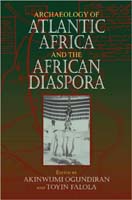
Akinwumi Ogundiran and Toyin Falola, editors. Archaeology of Atlantic Africa and the African Diaspora. Bloomington and Indianapolis, Indiana University Press, 2007, 509 pp., $59.95 (cloth), ISBN 978-0-253-34919-4.
Reviewed for the African Diaspora Archaeology Newsletter by Paula V. Saunders, BMCC, City University of New York.
Archaeology of Atlantic Africa and the African Diaspora represents the first substantive volume to respond to Merrick Posnansky's call for engagement between African Diaspora historical archaeologists in the Americas and Africanist archaeologists. The two regions, he argued, were intimately tied because of the slave trade, and as a result, understanding the contemporaneous material culture of each region is mutually beneficial to scholars working in both regions. While other works have covered broader issues relating to Africa and its diaspora, (such as Jay Haviser and Kevin MacDonald's edited volume, African Re-Genesis: Confronting Social Issues in the Diaspora, University College London Press, 2006), this volume is the first to focus entirely on the effects of the Atlantic trade on the material culture of everyday life and institutions in Africa and the Americas, the two regions most affected by the trade. Following a transatlantic perspective, this volume is an important contribution to understanding the diverse and global extent of African experiences and cultural transformations, as well as demonstrates the important role of Africa in the creation of the modern world.
This 509-page edited volume presents archaeological findings from a wide variety of regions, time periods, and topics related to African peoples throughout the Atlantic world in the historic period. The editors argue that their main goal in this collection of essays is to demonstrate some of "the consequences of Atlantic slavery on the peoples, societies, and institutions in Africa and the world of the enslaved and free Africans in the Americas." The editors argue that the findings in one location affects the study of the history of the other, and as such, there should be an active awareness and engagement of the work being conducted on each side of the Atlantic between the two groups. In addition, they advocate for the use of multiple sources of data, including material culture, written accounts, as well as oral traditions. In this collection of essays, the editors were successful in providing information on the material manifestations of the many exchanges and transformations which resulted from the Atlantic trade.
The work consists of twenty chapters, arranged in three parts: Part I is an introduction, Part II (Atlantic Africa) focuses on archaeological research on the African continent, while Part III (African Diaspora) examines sites related to African-descended people in the Americas. The chapters on Africa focus on the pre-existing economic and socio-political institutions, as well as how they were transformed as a result of the Atlantic trade. They emphasize African agencies and internal dynamics in Africa’s entanglement in the Atlantic world. The chapters on the African Diaspora focus primarily on sites related to the material culture of slavery and identities formed from the enslavement of African-descended peoples in the Americas. What follows is a detailed description of the subjects covered in the twenty chapters. [Read or download this full review here in Adobe .pdf format >>>].
[Return to table of contents]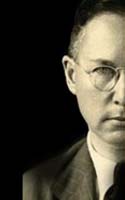
H-NET FILM REVIEW
Published by H-AfrArts, http://www.h-net.org/~artsweb/ (Sept. 2009).
Llewellyn Smith, Vincent Brown, Christine Herbes-Sommers, producers. Herskovits at the Heart of Blackness. DVD. A Vital Pictures Production. San Francisco California Newsreel, 2009. 56 minutes.
Reviewed for H-AfrArts by Ivor Miller
Naturalizing Identity Politics
Herskovits: at the Heart of Blackness examines the legacy of anthropologist Melville Herskovits, the founder of the first African Studies Center in the United States, at Northwestern University, as well as of the African Studies Association (ASA). Herskovits is portrayed not only as "the person who most demonstrates that African Americans are connected to Africans" in the pre-civil rights climate of the 1930s-50s, but also as the "Elvis of African American studies," because he brought these ideas into mainstream discourse, even as he may have "appropriated" Africa for his own ends--just as Elvis launched commercial white rock and roll by tapping the energy of the Afro-American blues.
The film's title riffs on Joseph Conrad's novel, evoking either the colonization of Africa or the use of Africans as a backdrop to play out foreign philosophical and existential struggles. The script opens with the question of how a white male scholar managed "to know so much about black people." Herskovits's family history is reviewed: his father's migration from eastern Europe and the struggle of second generation North Americans to find an identity -- "Can we be both Mexican/Jewish/Irish and American?" Herskovits's Jewish identity with a history of displacement is offered as a rationale for his eventual specialization in African American anthropology. At Columbia University, Franz Boas taught Herskovits the importance of cultural context, not biological inheritance, in determining the complex identities of individuals and groups in situations of mass migration and acculturation. This was in contrast to phrenology, the reigning theory of biological determinism, illustrated in the film with historical photographs and dramatized reenactments of white scientists measuring human physical features. As restagings continue throughout the program, the distinctions between archival footage and theater become blurred to the point of trivialization. More effective, because more sparingly used, is Herskovits's own film footage and photographs from fieldwork between 1928 and 1934, which included Dahomey (now the Benin Republic), the Georgia Sea Islands, the Gold Coast (now Ghana), Haiti, Nigeria, Suriname, and Trinidad.
Herskovits's relationship with African and African American scholars is reviewed. A towering presence in this program is Johnnetta Cole, the director of the National Museum of African Art, who was Herskovits's student at Northwestern. She articulates the influence of his cultural relativism: "Herskovits was clearly beyond where most folk were, [in teaching] that blacks were like any other humans"; and "I will always be grateful to Melville Herskovits for his contribution to my sense of self. He said that I had a culture, and it could be traced back to Africa." Cole also recalled the perceptions gathered about her mentor while a student: "Professor Herskovits seemed to think at some time that he owned Africa . . . . What if there were more African and African American scholars at Northwestern?" The film explores his debates with University of Chicago sociologist Franklin Frazier about the extent of African cultural influence among African descendants, as well as his complicated relationship with W. E. B DuBois, whom Herkovits portrayed as a propagandist for wishing to change society with his research. Katherine Dunham, who was helped by Herskovits during her research in Haiti in the 1930s, was lamentably absent from the discussion.
Throughout the film, appropriate attention is given to the issue of which powerful groups were funding what kinds of research in each period. In the 1930s, philanthropists wanted to fund studies of black Americans that would help diminish violent protests from these communities during the hard years of the Great Depression. Herskovits was able to publish his influential book The Myth of the Negro Past (1941), while DuBois never received funding for his Encyclopedia Africana; the documentary as much as indicts Herskovits for colluding with foundations to block DuBois's funding opportunities, although his motives are not clarified.
The post-WWII agitation by Africans against colonial rule led foundations that were linked to U.S. governmental agencies to support the creation of African studies programs. As a leading authority on Africa in the United States, Herskovits had founded the first African studies program in 1948. Yet, because he had taken the position that what the Nazis did in Europe was comparable to what colonists did in Africa, as well as his earlier participation in groups considered "communist" by the House Un-American Activities Committee, the FBI blocked his appointment by President John F. Kennedy to lead the Bureau of African Affairs.
After his death in 1963, several groups pointed to The Myth of the Negro Past as foundational to their activities, including black militants during the civil rights era, and Aimé Césaire, one of the founders of Negritude. In 1969 in Montreal, black activists stormed the ASA to challenge the largely white male conveners to include African descendants as scholars. Cole again articulates the agenda: "We want to be, as scholars of color, not only the objects of study, we want to be full participants. No more will we be relegated to the periphery. The real questions is 'who has access to understanding, to explaining a people, and to what use?'"
The heavy emphasis on the dramatizations of past events, like young Herskovits in his office, scientists measuring body parts, the African-descended students storming the ASA meeting in Montreal, suggest that the producers did not have enough archival material, explaining but not necessarily justifying their use of racial performance stereotypes. Also overdone is the discussion by African, African American, and Asian American professors about their own identities and their perceptions of how others perceive them. Harvard Professor Vincent Brown informs us that he is married to an Indian woman, and that when in India, some people thought he looked Japanese; and Princeton Professor Anthony Appiah informs us that East Indian taxi drivers in New York City want to position his "ethnic identity" in similar terms. But these digressions impose the standards of our day on Herskovits's time, long before the current vogue of identity politics in academia. More informative would have been a discussion of both race and class in the academy, since the perspectives of working-class people are as marginal to academic debates as those elites with controversial agendas for social justice, as the case of DuBois shows clearly. The video problematizes white access to knowledge about Africa, but seems to naturalize the identity politics model wherein only people of the same race or ethnicity have access to knowledge of, or the ability to speak for or about, an "ethnically" related group. Similarly, the film could have more forthrightly addressed the implication that Herskovits toned down his leftist politics as a strategy for winning acceptance in the academy.
Despite its flaws, the film's "stir-it-up" style will provoke lively discussions in the classroom about American intellectual and political history, twentieth-century anticolonial and antiracist movements, the relationship between anthropological observer and subject, and the socioeconomic context of research in the humanities.
Copyright (c) 2009 by H-Net, all rights reserved. H-Net permits the redistribution and reprinting of this work for nonprofit, educational purposes.[Return to table of contents]
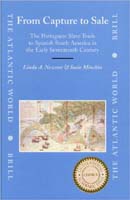
H-NET BOOK REVIEW
Published by H-Luso-Africa, http://www.h-net.org/~lusoafri/ (May 2009).
Linda A. Newson and Susie A. Michin. From Capture to Sale: The Portuguese Slave Trade to Spanish South America in the Early Seventeenth Century . Leiden and Boston: Brill, 2007. 378 pp., Cloth, ISBN 978-90-04-15679-1.
Reviewed for H-Luso-Africa by Tobias Green, University of Birmingham
Rethinking the Atlantic Slave Trade from the "Guinea of Cape Verde"
At first sight, the material of this major contribution to the study of the trans-Atlantic slave trade seems as though it should be more familiar than it is. The trade began, after all, through the Iberian Atlantic, and many of the practices which later slavers and plantation-owners developed in the Atlantic world derived from these early interactions. One need only look at the history of Barbados and South Carolina for the proof of this. Techniques of sugar cultivation and processing were introduced to Barbados from Brazil in the 1640s, and it was with this input that Barbadian planters switched from indentured British labor to enslaved African labor. Subsequently, many of the first settlers of South Carolina originated from Barbados. One may therefore draw a direct line between production techniques and racial attitudes developed in the Lusophone world to those which subsequently emerged in the lowcountry of the United States.
Such factors make the study of this early Iberian trade fundamental to understanding how the history of slavery in the Atlantic world developed. And yet, as the authors note in their introduction, there have been relatively few studies of the Portuguese slave trade to Spanish America, and in general the transatlantic slave trade of the sixteenth and seventeenth centuries is notably underrepresented in the literature on Atlantic slavery. Indeed there remains no monograph of the birth of the transatlantic slave trade in the sixteenth century, though this is something that the author of this review will shortly resolve.
The importance of Newson and Minchin's work is twofold. In the first place, they have uncovered precious new documentation in the Archivo General de la Nación in Lima which gives perhaps the most detailed record we have for the entire proceedings of a slave-trading enterprise from the 1610s. The slaver in question, Manuel Bautista Pérez, was much later arrested, tried, and put to death by the Inquisition in Lima, which is why the records were preserved.[1] In the second place, they have pieced together perhaps the most detailed account we have of the lives of slaves in this Iberian trade during every aspect of their transatlantic migration, from capture to sale, as their title suggests.
The focus of the book is particularly on slave health, diet, conditions, and medicinal treatments at every juncture of the voyage. This apparently quite confined narrative focus is in fact a window onto the experience of slaves in the trade, as the emphasis on diet reveals the conditions of slaves during their migration and the type of physical experience which they had. Such an emphasis is quite rare in a literature, which has been beset by the issue of quantification ever since the annalistes got their hands on it, and which still struggles to slough off this unhelpful legacy off.
Members of this list will find the earlier chapters of most interest to their own research. Here, the authors deal with the ways in which slave voyages were fitted out, develop a detailed picture of how slaves were procured on the coast of Upper Guinea in the Cacheu region (present-day Guinea-Bissau), the conditions in which slaves were kept on the coast, and the nature of the Middle Passage during the journey to Cartagena in the Nuevo Reino de Granada (present-day Colombia). Although the authors’ prime focus in their African chapters is on the Guinea-Bissau region, some useful comparative details emerge in their comparison of the diseases, which slaves from Upper Guinea and Angola had on their arrival in the Americas. These details allow them to draw important conclusions relating to agricultural production, diets, and health in these parts of Africa in the early seventeenth century, which is an important contribution to our understanding of precolonial everyday life in these regions of such interest to this list.
The Upper Guinea focus also acts as a useful corrective to some of the recent literature which has suggested that after the late sixteenth century the transatlantic slave trade had an almost exclusively West Central African make-up.[2] Such ideas are certainly incompatible with the findings of this book, which observes the following percentages of slaves from the Upper Guinea region among those sold in Cartagena between 1626 and 1633: 1626 - 33.3 percent; 1627 – 70.5 percent; 1628 – 70.2 percent; 1629 – 83 percent; 1630 – 53.3 percent; 1631 – 31.7 percent; 1632 – 11.5 percent; 1633 – 54.5 percent (p. 153).
This is a book which scholars need to consider with care and detailed attention. One suspects -- and indeed the authors themselves admit -- that their use of the Lima material is just one aspect of the many new interpretations which the documents may offer. And the sign of an original work is one which, like this book, provokes as many questions as it provides answers.
Notes[1]. For other detailed studies of Bautista Pérez, see in particular Susie Minchin, "'May You Always Care for Those of Your Patria': Manuel Bautista Pérez and the Portuguese New Christian Community of Viceregal Peru: Slave Trade, Commerce and the Inquisition, 1617-1639" (Ph.D. diss., University of Cambrudge, 1998); Nathan Wachtel, La Foi du Souvenir: Labyrinthes Marranes (Paris: Éditions du Seuil, 2001); and Tobias Green, "Masters of Difference: Creolization and the Jewish Presence in Cabo Verde, 1497-1672" (Ph.D. diss., University of Birmingham, 2007).
[2]. See Linda Heywood and John Thornton, Central Africans, Atlantic Creoles and the Foundation of the Americas, 1585-1660 (Cambridge: Cambridge University Press, 2007).
Copyright (c) 2009 by H-Net, all rights reserved. H-Net permits the redistribution and reprinting of this work for nonprofit, educational purposes.
[Return to table of contents]
